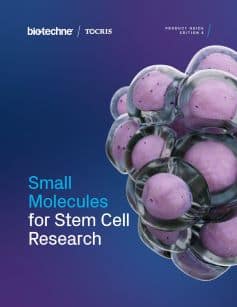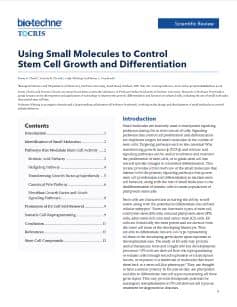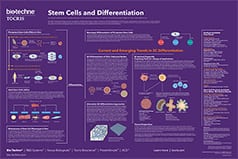Stem Cell Proliferation
Cellular proliferation describes an increase in cell number resulting from cell growth and division into two identical daughter cells. Production of cells identical to the parent is termed 'self-renewal.' Unlike other cell types, stem cells have the ability to replicate many times.
Kits |
|
|---|---|
| Cat. No. | Product Name / Activity |
| 7991 | CEPT Cocktail Kit |
| Cell culture supplement for improving stem cell survival | |
Other |
|
| Cat. No. | Product Name / Activity |
| 3336 | A 769662 |
| Potent AMPK activator; inhibits MSC proliferation | |
| 2939 | A 83-01 |
| Maintains self-renewal of human iPSCs; selective inhibitor of TGF-βRI, ALK4 and ALK7 | |
| 7001 | AT 7867 |
| Induces proliferation of iPSC-derived pancreatic progenitor cells; pan-Akt and PKA inhibitor | |
| 3194 | BIO |
| Maintains self-renewal and pluripotency of ESCs; potent inhibitor of GSK-3; also inhibits cdks | |
| 7372 | CDK8/19i |
| Potent and selective CDK8 and CDK19 inhibitor; maintains pluripotency of mouse PSCs in culture | |
| 7368 | Cell Counting Kit-8 |
| Cell viability and proliferation assay test solution | |
| 1063 | CGS 21680 hydrochloride |
| Increases proliferation of NPCs; potent A2A receptor agonist | |
| 3858 | CH 223191 |
| AhR antagonist; promotes expansion of human hematopoietic stem cells | |
| 7163 | Chroman 1 |
| Highly potent and selective ROCK 2 inhibitor; improves cell survival after cryogenesis | |
| 8917 | Cyclo(-RGDfK) New |
| Improves stem cell attachment in 3D cell culture scaffolds; also potent integrin inhibitor | |
| 4027 | 16,16-Dimethyl Prostaglandin E2 |
| Induces stem cell proliferation | |
| 6019 | Diprotin A |
| Increases number of viable HSC during harvesting; DPP-IV inhibitor | |
| 7726 | DMSO, Cell Cryopreserve Grade |
| Intracellular cryoprotective agent | |
| 1261 | EHNA hydrochloride |
| Suppresses spontaneous differentiation of human ESCs; adenosine deaminase inhibitor | |
| 7310 | Emricasan |
| Promotes survival of hPSCs in combination with other small molecules; potent pan-caspase inhibitor | |
| 6961 | FzM1.8 |
| Preserves stemness and promotes proliferation of undifferentiated cells; Frizzled 4 allosteric agonist | |
| 2285 | Go 6983 |
| Optimizes naïve human pluripotent stem cell growth and viability; PKC inhibitor | |
| 2910 | H 89 dihydrochloride |
| Improves survival and clonogenicity of dissociated human ESCs; PKA inhibitor | |
| 4997 | INDY |
| Dyrk1A/B inhibitor; impairs self-renewal of NSCs | |
| 5284 | trans-ISRIB |
| Promotes survival of hPSCs in combination with other small molecules; also integrated stress response (ISR) inhibitor | |
| 3533 | IWP 2 |
| PORCN inhibitor; suppresses self-renewal in R1 ESCs | |
| 1130 | LY 294002 hydrochloride |
| Prototypical PI 3-kinase inhibitor; suppresses proliferation of mESCs | |
| 1671 | PD 102807 |
| Promotes expansion of erythroid progenitors | |
| 3044 | PD 173074 |
| Selective FGFR1 and -3 inhibitor; inhibits proliferation and differentiation of oligodendrocyte progenitors | |
| 1213 | PD 98059 |
| MEK inhibitor; enhances ESC self-renewal | |
| 4124 | Pioglitazone hydrochloride |
| Acts synergistically with Y-27632 (Cat.No. 1254) to improve PSC cloning efficiency; PPARγ agonist | |
| 7739 | Polyamine Supplement x1000 (lyophilized) |
| Media supplement to boost cell growth; used as component of CEPT cocktail to enhance stem cell viability | |
| 2296 | Prostaglandin E2 |
| Induces hematopoietic stem cell proliferation | |
| 4978 | Pyrintegrin |
| Enhances survival of human ESCs following enzymatic dissociation | |
| 7723 | RGD peptide |
| Directs association of stem cells with diverse biomaterials; increases cell spreading | |
| 1264 | SB 202190 |
| Promotes stability of human PSCs; potent, selective inhibitor of p38 MAPK | |
| 1202 | SB 203580 |
| Selective inhibitor of p38 MAPK; stimulates neural stem cell proliferation | |
| 1616 | SB 216763 |
| GSK-3 inhibitor; maintains mouse ESCs in a pluripotent state | |
| 1614 | SB 431542 |
| Induces proliferation, differentiation and sheet formation of ESC-derived endothelial cells | |
| 3784 | Sildenafil citrate |
| Promotes mobilization of hematopoietic stem cells (HSCs) in combination with AMD 3100; potent PDE5 inhibitor | |
| 1496 | SP 600125 |
| Used for maintaining stem cells in naive pluripotent state; selective JNK inhibitor | |
| 7086 | StemRegenin 1 |
| Aryl hydrocarbon receptor (AhR) antagonist; promotes HSC expansion and engraftment | |
| 3300 | SU 5402 |
| Supports mESC self-renewal; potent FGFR and VEGFR inhibitor | |
| 6634 | Surfen |
| Maintains pluripotency of hESCs; heparin sulfate antagonist | |
| 5759 | SW 033291 |
| High affinity 15-PGDH inhibitor; promotes hematopoiesis and hepatocyte proliferation | |
| 3845 | Thiazovivin |
| Improves survival of hESCs; ROCK inhibitor | |
| 7340 | Tocriscreen Stem Cell Library |
| A library of 120 stem cell compounds (100 μL 10 mM DMSO solutions) to explore stem cell reprogramming, differentiation, proliferation and signaling | |
| 3114 | Troglitazone |
| Selective PPARγ agonist; inhibits growth of hematopoietic cell lines | |
| 1144 | U0126 |
| Regulates hPSCs self-renewal; also potent, selective inhibitor of MEK1 and 2 | |
| 5413 | WH-4-023 |
| Supports self-renewal of naive hESCs | |
| 7791 | WS 6 |
| Induces growth and proliferation of pancreatic islet cells, murine totipotent stem cells, GABAergic neurons and hippocampal neurons | |
| 1254 | Y-27632 dihydrochloride |
| Selective ROCK inhibitor; increases survival rate of human embryonic stem cells undergoing cryopreservation | |
| 7000 | Y-27632 in solution |
| Sterile-filtered 10 mM solution of Y-27632, selective ROCK inhibitor, pre-dissolved in water | |
| 6599 | Yhhu 3792 |
| Enhances the self-renewal capability of NSCs; notch signaling pathway activator; active in vivo | |
Pluripotent Stem Cell Maintenance
Proliferation and self-renewal of stem cells occurs via the division of a cell into two identical daughter cells, resulting in the production of cells identical to the parent. Unlike other cell types, such as muscle or blood cells, stem cells are able to replicate many times. Under the right conditions stem cells can continue to proliferate in culture over many months without differentiation and specialization, yielding millions of cells; this is known as long-term self-renewal.
The maintenance of stem cells in the undifferentiated pluripotent state is controlled by a range of intrinsic and extrinsic factors including signaling pathways, growth factors and transcription factors. The stable expression of three core transcription factors, Oct4, Sox2 and Nanog, are key to maintaining pluripotency and self-renewal of embryonic stem cells (ESC).
Oct4, Sox2 and Nanog enhance the activity of genes associated with maintaining the pluripotent state, while repressing genes that enable differentiation. These core transcription factors function together and form an autoregulatory loop. When all three factors are expressed at the appropriate levels, the autoregulatory loop functions as a positive feedback control of gene expression that maintains stem cells in the pluripotent state. However, if the expression of one of the transcription factors is altered, gene expression is switched to a differentiation program. DNA sites occupied by Oct4, Sox2 and Nanog are also co-occupied by Stat3, Tcf3 and Smad1, which are the target transcription factors of the LIF, Wnt and TGF-β/BMP pathways, respectively. This allows for control of the core factors and therefore self-renewal/differentiation by these signaling pathways.
Conventional stem cell culture techniques previously required mouse embryonic fibroblast (MEF) 'feeder' cells, serum products and growth factors, such as LIF and bFGF. Recently, it has been shown that stem cell expansion can take place in culture without feeder cells, but in chemically-defined, serum-free media by supplementation with LIF and/or BMP. LIF alone cannot maintain stem cell self-renewal, but concomitant activation of the Wnt signaling pathway by inhibition of GSK-3β using the small molecule BIO (Cat. No. 3194), maintains human and mouse embryonic stem cells in the undifferentiated state and sustained the expression of the pluripotency associated transcription factors Oct-3/4, Rex-1 and Nanog.
2i-containing Medium
Ying et al. (2008) postulated that the LIF and BMP signals act downstream from ERK to block ESC commitment. To test this theory, they cultured mESCs in a combination of LIF plus the small molecule MEK inhibitor PD 184352 (Cat. No. 4237) and the FGF receptor tyrosine kinase inhibitor SU 5402 (Cat. No. 3300), as a substitute for serum/BMP and found that the combination could support ES cell expansion. However, occasional neural rosettes appeared, and apoptosis was relatively high using this combination. Given that it had previously been demonstrated that a GSK-3β inhibitor (BIO, Cat. No. 3194) could maintain self-renewal, the researchers next explored whether adding the more selective GSK-3β inhibitor CHIR 99021 (Cat. No. 4423) could enhance growth of ESCs cultured in a combination of PD 184352 and SU 5402. It was found that the combination of these three inhibitors (3i) led to expansion of ESC colonies for several weeks with a doubling rate comparable to that with LIF/serum/BMP. Replacing PD 184352 and SU 5402 with the more potent MEK inhibitor PD 0325901 (Cat. No. 4192), to achieve more effective inhibition of ERK activation, was subsequently shown to be sufficient to sustain ESC self-renewal. This two-inhibitor combination of CHIR 99021 and PD 0325901, known as 2i, can maintain pluripotent stem cell self-renewal in the absence of feeder cells and exogenous growth factors.
In addition to the known advantages of using small molecules in the stem cell workflow, i.e. they are chemically-defined and cell-permeable, Tamm et al. (2013) reported that ESCs grown in 2i medium show lower levels of spontaneous differentiation compared with standard stem cell culture methods. 2i can also effectively rescue cultures that have started to differentiate and can be used to adapt feeder-dependent mESCs to feeder-free surfaces with little evidence of cell death.
ROCK Inhibition
While pluripotent stem cells can self-renew in the long-term in 2i containing medium, they are vulnerable to apoptosis during single-cell dissociation in routine passage. The ROCK (Rho-associated coiled-coil kinase) inhibitor, Y-27632 (Cat. No. 1254), can significantly reduce dissociation-induced apoptosis in ESCs, improving cell survival and colony formation. One-hour pretreatment of hESCs with Y-26732, prior to dissociation and plating on a MEF feeder layer improves cloning efficiency enabling cells to grow and differentiate through multiple passages.
hESCs exhibit integrin-dependent matrix adhesion and E-cadherin-dependent cell-cell adhesion; single-cell dissociation leads to disruption of these interactions resulting in apoptosis. The loss of E-cadherin-dependent intercellular contact leads to hyperactivation of Rho/ROCK signaling. Conversely ROCK inhibition leads to increased E-cadherin levels and cell attachment to the extracellular matrix (ECM). In addition, cells plated onto an E-cadherin-coated plate show decreased Rho activity, indicating that E-cadherin-mediated cell-cell interaction likely regulates Rho/ROCK activity in hESCs. Pyrintegrin (Cat. No. 4978) enhances cell-ECM adhesion-mediated integrin signaling and improves cloning efficiency of hESCs, but has no effect on ROCK.
The peroxisome proliferator-activated receptor γ (PPARγ) activator Pioglitazone (Cat. No. 4124) has been shown to act synergistically to enhance the effects of Y-27632 on dissociation-induced apoptosis, improving cloning efficiency of hESCs and hiPSCs by 2-3-fold compared with ROCK inhibitor alone in feeder-free culture systems. Together Pioglitazone and Y-27632 upregulate E-cadherin and β-catenin, which are downregulated in dissociated stem cells. PPARγ acts via inhibition of GSK-3β to increase membranous β-catenin levels, which interacts with E-cadherin. Pioglitazone alone has no effect on cloning efficiency.
Monitoring Pluripotent Stem Cells
Kyoto Probe-1 (KP1, Cat. No. 7419) is a useful tool for monitoring pluripotency during ESC and iPSC maintenance. This fluorescent probe localizes to mitochondria in undifferentiated iPS/ES cells only and so distinguishes differentiated from undifferentiated cells. It is suitable for use in live cell imaging as well as flow cytometry.
Maintenance of Differentiated Cells
In addition to preserving the stemness of PSCs, it is also important to develop methods to maintain lineage-restricted or terminally differentiated cells in a differentiated state. This is particularly critical for cell therapy purposes, for example in regenerative medicine, as differentiated cell types are less prone to teratoma formation than PSCs. However long-term maintenance of terminally differentiated cells presents challenges, since differentiated cells often lose their identity and functionality in culture. Maintenance of cell function is regulated by a network of signaling pathways and these need to be recapitulated in vitro to stabilize cells over the long term.
Li et al. (2011) established chemically-defined conditions for the maintenance of hESC-derived primitive neuroepithelium in vitro using LIF, CHIR 99021 and the TGF-β receptor inhibitor SB 431542 (Cat. No. 1614). In the presence of this cocktail of reagents, primitive neural stem cells (pNSCs) self-renew over multiple passages on basement membrane extract (BME; e.g. Cultrex™, available from R&D Systems), maintaining a stable NSC phenotype and retaining the ability to differentiate into midbrain and hindbrain neuronal cell types in response to the appropriate cues.
More recently Chen et al. (2021) identified a different cocktail of small molecules, a combination of Chroman 1 (Cat. No. 7163), Emricasan (Cat. No. 7310), Polyamine Supplement (Cat. No. 7739), and Trans-ISRIB (Cat. No. 5284) termed CEPT, which improves the viability of hPSCs. This combination also significantly improved cell survival during embryoid body and organoid formation compared with Y-27632 alone.
Stem Cell Cryopreservation/Storage
The successful use of stem cells for research and stem cell therapy, including for regenerative medicine, requires efficient storage by cryopreservation. There are two cryopreservation methods, fast and slow freezing, neither of which are efficient. After slow freezing, the survival rate of hESCs and hiPSCs is poor, at around 10%. Improvement in hESC survival post-thaw can be achieved by first treating cells with ROCK inhibitor Y-27632 prior to dissociation, then slow freezing and storage as single cells rather than clumps. Y-27632 added to the cryopreservation medium has also been shown improve post-thaw survival of hESCs cultured on feeder layers (Figure 1).

Figure 1: Using ROCK inhibitor Y-27632 to improve cell survival in cryopreservation.
Addition of ROCK inhibitor Y-27632 to the post-thaw culture medium can also improve the viability of cryopreserved hESCs and hiPSCs compared with untreated cells. Treatment with ROCK inhibitor increases the adherent properties of cells post-thaw. Y-27632-treated freeze-thawed hESCs also retain morphology, stable karyotype, expression of cell surface markers, and pluripotency. In addition, the CEPT cocktail, described by Chen et al. (2021) was shown to improve survival of differentiated cells following cryopreservation, with cardiomyocyte survival increasing by 36% and motor neuron survival increasing by 63% compared to DMSO controls.
Related Products and Services From Our Sister Brands
Literature for Stem Cell Proliferation
Tocris offers the following scientific literature for Stem Cell Proliferation to showcase our products. We invite you to request* your copy today!
*Please note that Tocris will only send literature to established scientific business / institute addresses.
Stem Cells Scientific Review
Written by Kirsty E. Clarke, Victoria B. Christie, Andy Whiting and Stefan A. Przyborski, this review provides an overview of the use of small molecules in the control of stem cell growth and differentiation. Key signaling pathways are highlighted, and the regulation of ES cell self-renewal and somatic cell reprogramming is discussed. Compounds available from Tocris are listed.
Stem Cell Workflow Poster
Stem cells have potential as a source of cells and tissues for research and treatment of disease. This poster summarizes some key protocols demonstrating the use of small molecules across the stem cell workflow, from reprogramming, through self-renewal, storage and differentiation to verification. Advantages of using small molecules are also highlighted.



